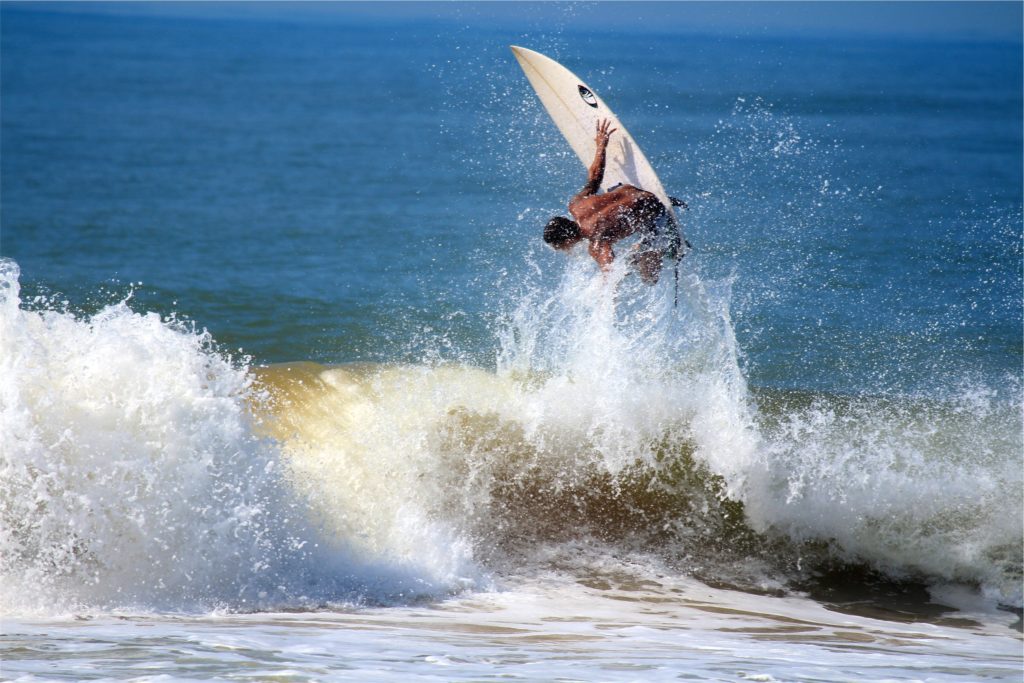Although serious injuries are somewhat less common in the sport of surfing when compared to contact sports, there is no shortage of risk when it comes to riding waves.
This post will discuss tips to prevent surfing injuries and keep you in the water:
Warm-up
We all know warming up helps prepare the body for activity and reduces the risk of injury. More specifically the benefits of a good warm up include:
- Increased blood flow and oxygen delivery to muscles, smoother muscle contraction and efficiency leading to smoother, graceful surfing.
- Increased speed of nerve impulses thus improving reaction time on your board when you hit the water.
Stretching
Stretching allows the joints to move more smoothly though a full range of motion and is essential to increased performance in the water. Like most other physical activities, surfing requires agility and quick movements, so loosening up your major muscle groups will give you greater flexibility and reduce the likelihood of injuring yourself.
Core Strengthening
Having a strong core is essential to surfing. Two key factors to surfing include power and stability, both of which are achieved by having a strong core. In addition to improved power when you pop up to catch that next wave, strengthening your core will also help you avoid injuries.
A few examples of surfing specific core exercises that you may find useful are:
Plank
Begin by laying facedown. Support your upper body on your elbows, which should be bent to a 90-degree angle and aligned directly under your shoulders. Keeping abdominals pulled inwards, push up onto the balls of your feet. You should be in a straight line with your weight supported on your toes, elbows and forearms. Try to keep from arching your back or allowing for your butt to lift into the air. Hold for 30 seconds. A good goal is to be able to hold the plank for 60 seconds.
Ball Push-Ups
To start this exercise, kneel behind the ball and lay your stomach on top of it. Pull your body forward on the ball until your hands are touching the ground in front of you. Slowly walk yourself forward until the ball is supporting your knees and lower legs. You should be in a push-up position with your lower body elevated on the ball. Slowly bend your elbows and lower yourself down until your nose almost touches the ground. Straighten your elbows and return to the beginning. Repeat 10 times.
Side Plank
The side plank helps build core stabilizers or the muscles that support the shoulder girdle and the lower back. Start this exercise by lying on your left side with your left hand, palm down, under you shoulder. Place your right hand in front of your body for support. Keeping your abdominals pulled in, push into your left hand and lift up your hips into a side plank position. Hold for 30 seconds. A good goal is to be able to hold the plank for 60 seconds.
Back Extensions
Begin this exercise by lying on your stomach with your forehead on the floor. Your arms will be straight out in front of you with palms down and legs straight behind you. Pull your abs in and lift your left arm and right leg a couple inches off the floor. Hold for five seconds and stretch out both your arm and leg to maximizing this exercise. Lower back to the start and repeat with the opposite sides. Do each side a total of five times.
Completing these core exercises should help you avoid some injuries experienced while surfing.
Rest and sleep
Seems obvious but adequate rest and sleep are essential if a surfer is to cope with lots of water time and remain injury free.
Good nutrition and hydration
Nutrition aids recovery from surfing by replenishing glycogen stores and by providing necessary protein. The ‘Australian Dietary Guidelines’ provide a simple, scientific, balanced and sustainable approach to adjusting your eating for optimal health and function in the water.
By far the most frequent ailment suffered by surfers is dehydration, and for good reason. A large percentage of surf sessions happen under the bright glare of the sun, where a lack of proper hydration can turn a healthy athlete into a floundering vegetable in a matter of minutes. This is not complicated. To combat dehydration, hydrate. It sounds easy, but it’s amazing how many surfers forget to drink enough water before and after spending time in the ocean.
For more information regarding injury prevention or to arrange an assessment aimed to correct any predisposing biomechanical risks contact one of the physiotherapists at Jubilee Sports Physiotherapy.






















